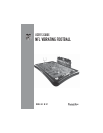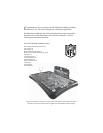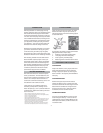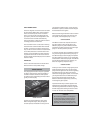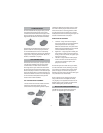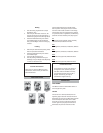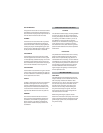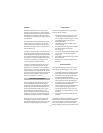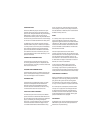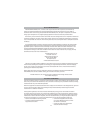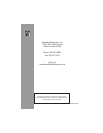FORWARD PASS
Once the off ensive player touches the quar-
terback during the play he must attempt to
pass or kick. The quarterback may be manually
faded back or to the side, but may not be
moved forward. The passer may not fade back
more than 30 yards from the line of scrimmage
or the ball is considered downed at that point.
If a defensive man moves “behind” the quar-
terback before the pass is released, the passer
is under pressure, and must pass immediately.
The vibration should be turned off , and the
pass must be thrown. The off ense is allowed
time to fi nd a receiver and aim the pass, but
the quarterback must remain stationary at his
place on the fi eld.
COMPLETED FORWARD PASS
If the ball hits an eligible receiver (in the air
or on the ground) the pass is completed, the
switch turned on, and play continues with that
man as the ball carrier.
INCOMPLETE FORWARD PASS
If the ball does not hit an eligible receiver, the
pass is incomplete and play is resumed at the
line of scrimmage on the next down.
INTERCEPTION
If the ball hits any defensive player, the pass
has been intercepted. The ball should be
placed in the arms of the defensive player
and the vibration should be turned on. Play
continues with that man as ball carrier.
PITCHOUTS AND LATERALS
To execute a pitch-out or lateral, the off ense
passes the ball to a teammate behind the line
of scrimmage. If the ball touches any off ensive
player, (on the fl y or on the ground), the
pitch-out is caught and the play is continued.
If the ball touches a defensive player fi rst, it
is considered fumbled and the defense may
pick it up and run. If the ball falls on the fi eld
and no player touches it, the player closest to
the ball (off ense or defense) has recovered the
fumble and may return it.
PUNT
It is usually wise to punt on fourth down
unless the off ense is within 30 yards of the
opponent’s goal line. The kick is made with the
vibration on. After the kick, the defensive man
nearest to where the ball hit becomes the ball
carrier. The fi eld is turned off the moment the
ball touches the fi eld.
The ball is placed under the arm of the
receiver, and the receiver may be aimed in the
desired direction. No other players on the fi eld
may be moved. When the ball carrier is set,
the vibration is turned back on and the return
is made until the player is tackled, runs out of
bounds, or scores a touchdown.
In the event the defense does not have a
man at least thirty yards behind the line of
scrimmage, a punt return is prohibited. The
receiving team must then put the ball into play
at the point at which the ball has come to rest.
CONVERSION ATTEMPTS
After a touchdown is scored, the scoring team
attempts a conversion by putting the ball into
play at the two-yard line. The scoring team
may attempt an extra point with a placekick,
or a try to run or pass for a 2-point conversion.
If an extra point is attempted, the two teams
line up as in a play from scrimmage. The ball
is placed on the kicking tee, the vibration is
turned on and the kick is attempted. The ball
must be kicked over the crossbar of the goal
posts and between the uprights.
FIELD GOAL
A fi eld goal may not be attempted behind the
off ense’s 45-yard line. The same procedure is
followed as in placekicking.
9



